stop start TOYOTA COROLLA HATCHBACK 2022 (in English) Manual Online
[x] Cancel search | Manufacturer: TOYOTA, Model Year: 2022, Model line: COROLLA HATCHBACK, Model: TOYOTA COROLLA HATCHBACK 2022Pages: 758, PDF Size: 155.26 MB
Page 524 of 758
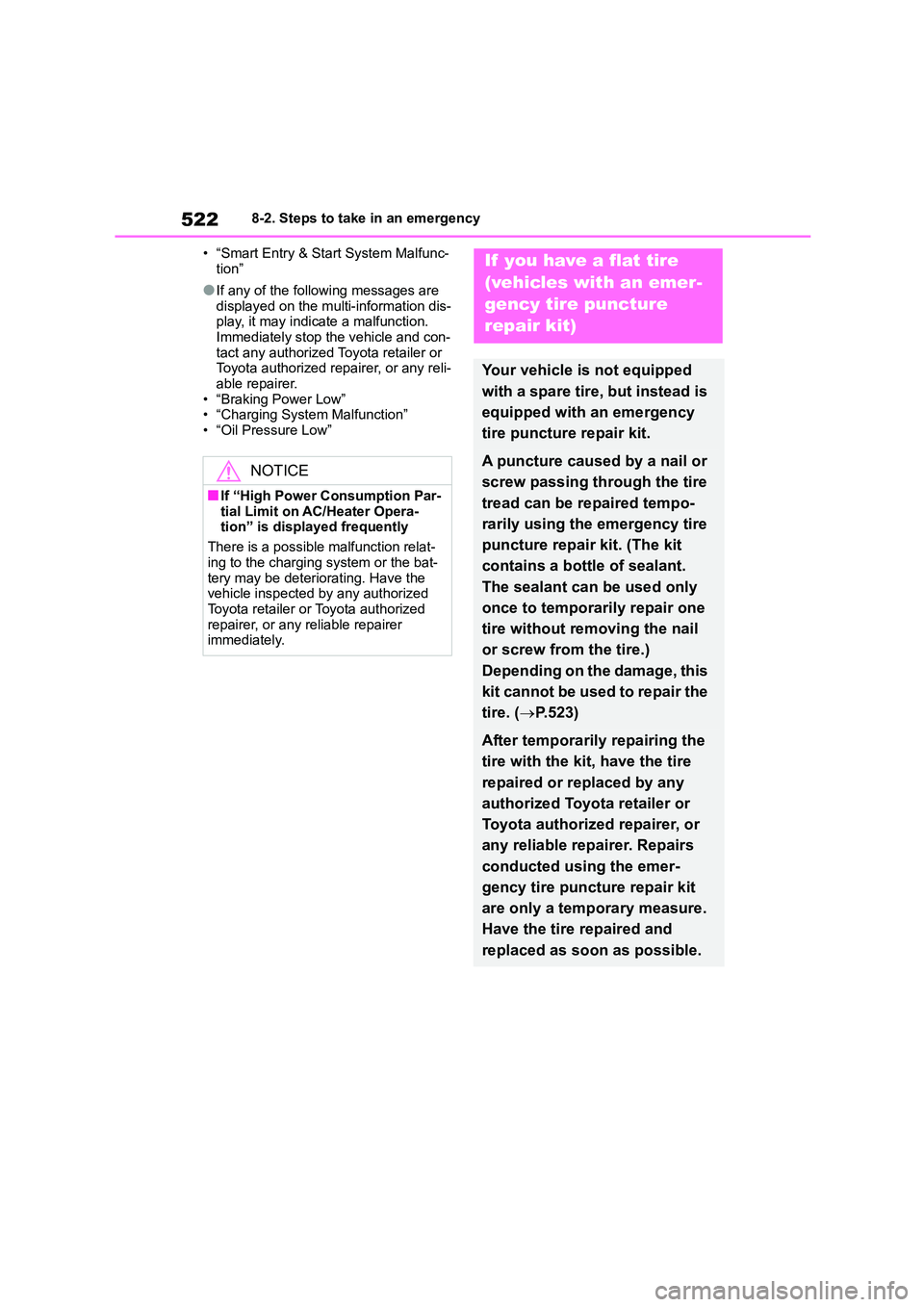
5228-2. Steps to take in an emergency
• “Smart Entry & Start System Malfunc-
tion”
●If any of the following messages are
displayed on the multi-information dis- play, it may indicate a malfunction.
Immediately stop the vehicle and con-
tact any authorized Toyota retailer or Toyota authorized repairer, or any reli-
able repairer.
• “Braking Power Low” • “Charging System Malfunction”
• “Oil Pressure Low”
NOTICE
■If “High Power Consumption Par-
tial Limit on AC/Heater Opera- tion” is displayed frequently
There is a possible malfunction relat-
ing to the charging system or the bat- tery may be deteriorating. Have the
vehicle inspected by any authorized
Toyota retailer or Toyota authorized repairer, or any reliable repairer
immediately.
If you have a flat tire
(vehicles with an emer-
gency tire puncture
repair kit)
Your vehicle is not equipped
with a spare tire, but instead is
equipped with an emergency
tire puncture repair kit.
A puncture caused by a nail or
screw passing through the tire
tread can be repaired tempo-
rarily using the emergency tire
puncture repair kit. (The kit
contains a bottle of sealant.
The sealant can be used only
once to temporarily repair one
tire without removing the nail
or screw from the tire.)
Depending on the damage, this
kit cannot be used to repair the
tire. ( P.523)
After temporarily repairing the
tire with the kit, have the tire
repaired or replaced by any
authorized Toyota retailer or
Toyota authorized repairer, or
any reliable repairer. Repairs
conducted using the emer-
gency tire puncture repair kit
are only a temporary measure.
Have the tire repaired and
replaced as soon as possible.
Page 558 of 758
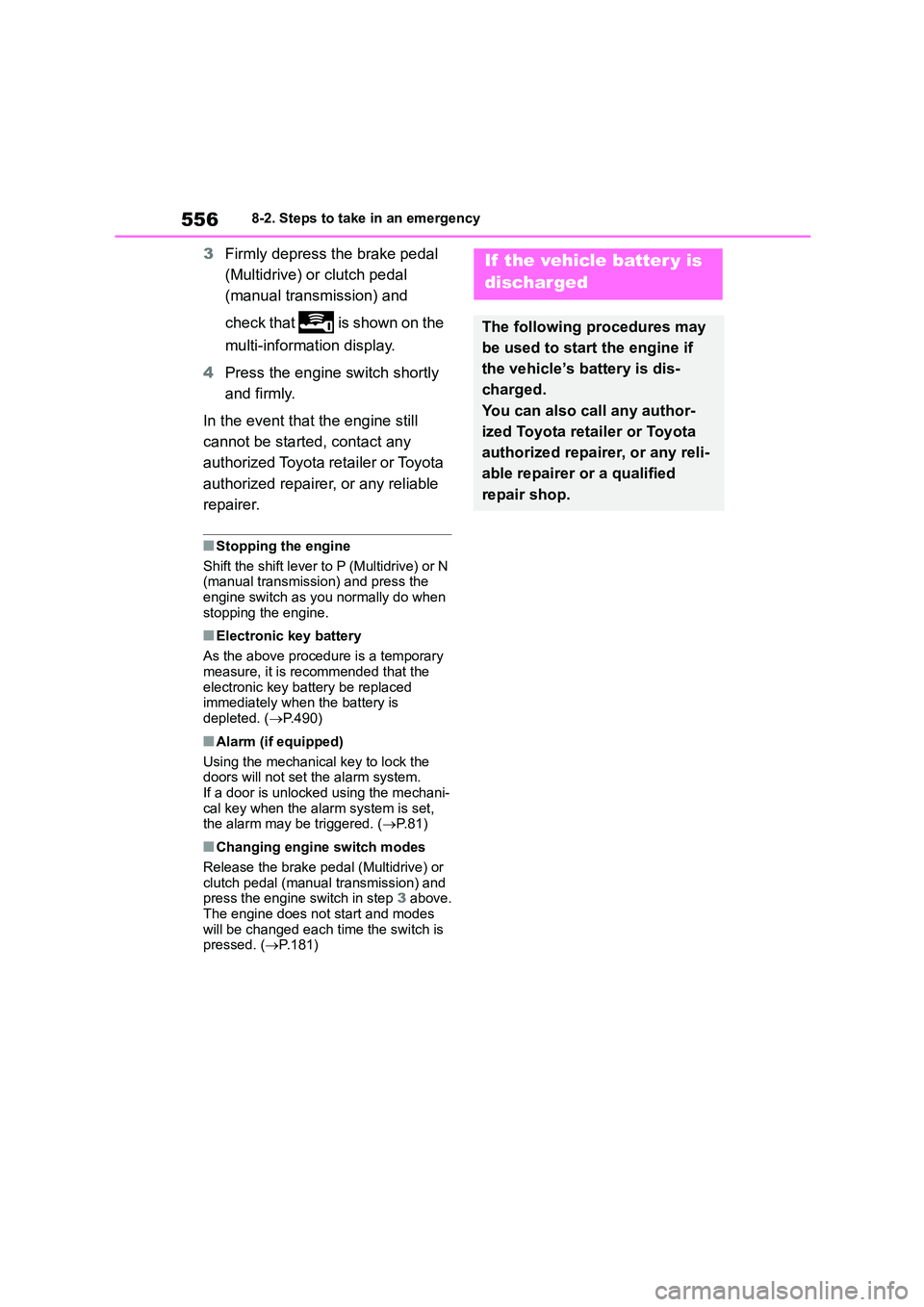
5568-2. Steps to take in an emergency
3Firmly depress the brake pedal
(Multidrive) or clutch pedal
(manual transmission) and
check that is shown on the
multi-information display.
4 Press the engine switch shortly
and firmly.
In the event that the engine still
cannot be started, contact any
authorized Toyota retailer or Toyota
authorized repairer, or any reliable
repairer.
■Stopping the engine
Shift the shift lever to P (Multidrive) or N
(manual transmission) and press the
engine switch as you normally do when stopping the engine.
■Electronic key battery
As the above procedure is a temporary
measure, it is recommended that the electronic key battery be replaced
immediately when the battery is
depleted. ( P.490)
■Alarm (if equipped)
Using the mechanical key to lock the doors will not set the alarm system.
If a door is unlocked using the mechani-
cal key when the alarm system is set, the alarm may be triggered. ( P.81)
■Changing engine switch modes
Release the brake pedal (Multidrive) or
clutch pedal (manual transmission) and press the engine switch in step 3 above.
The engine does not start and modes
will be changed each time the switch is pressed. ( P.181)
If the vehicle batter y is
discharged
The following procedures may
be used to start the engine if
the vehicle’s battery is dis-
charged.
You can also call any author-
ized Toyota retailer or Toyota
authorized repairer, or any reli-
able repairer or a qualified
repair shop.
Page 560 of 758

5588-2. Steps to take in an emergency
minutes to recharge the battery
of your vehicle.
5 Vehicles with a smart entry &
start system: Open and close
any of the doors of your vehicle
with the engine switch OFF.
6 Maintain the engine speed of
the second vehicle and start the
engine of your vehicle by turning
the engine switch to ON.
7 Once the vehicle’s engine has
started, remove the jumper
cables in the exact reverse
order from which they were con-
nected.
Once the engine starts, have the
vehicle inspected at any author-
ized Toyota reta iler or Toyota
authorized repairer, or any reliable
repairer as soon as possible.
■Starting the engine when the bat- tery is discharged
The engine cannot be started by
push-starting.
■To prevent battery discharge
●Turn off the headlights and the audio
system while the engine is stopped.
(Vehicles with Stop & Start system: except when the engine is stopped by
the Stop & Start system.)
●Turn off any unnecessary electrical
components when the vehicle is run-
ning at a low speed for an extended period, such as in heavy traffic.
■When the battery is removed or dis-
charged
●Information stored in the ECU is
cleared. When the battery is depleted,
have the vehicle inspected at any authorized Toyota retailer or Toyota
authorized repairer, or any reliable
repairer.
●Some systems may require initializa-
tion. ( P.587)
■When removing the battery termi- nals
When the battery terminals are
removed, the information stored in the ECU is cleared. Before removing the
battery terminals, contact any author-
ized Toyota retailer or Toyota authorized repairer, or any reliable repairer.
■Charging the battery
The electricity stored in the battery will
discharge gradually even when the vehi- cle is not in use, due to natural dis-
charge and the draining effects of
certain electrical appliances. If the vehi- cle is left for a long time, the battery may
discharge, and the engine may be una-
ble to start. (The battery recharges auto- matically during driving.)
■When recharging or replacing the
battery
●Vehicles with a smart entry & start
system: In some cases, it may not be
possible to unlock the doors using the smart entry & star t system when the
battery is discharged. Use the wire-
less remote control or the mechanical key to lock or unlock the doors.
●Vehicles with a smart entry & start system: The engine may not start on
the first attempt after the battery has
recharged but will start normally after the second attempt. This is not a mal-
function.
●Vehicles with a smart entry & start
system: The engine switch mode is
memorized by the vehicle. When the
battery is reconnected, the system will return to the mode it was in before the
battery was discharged. Before dis-
connecting the battery, turn the engine switch off.
If you are unsure what mode the
engine switch was in before the bat- tery discharged, be especially careful
when reconnecting the battery.
Page 561 of 758
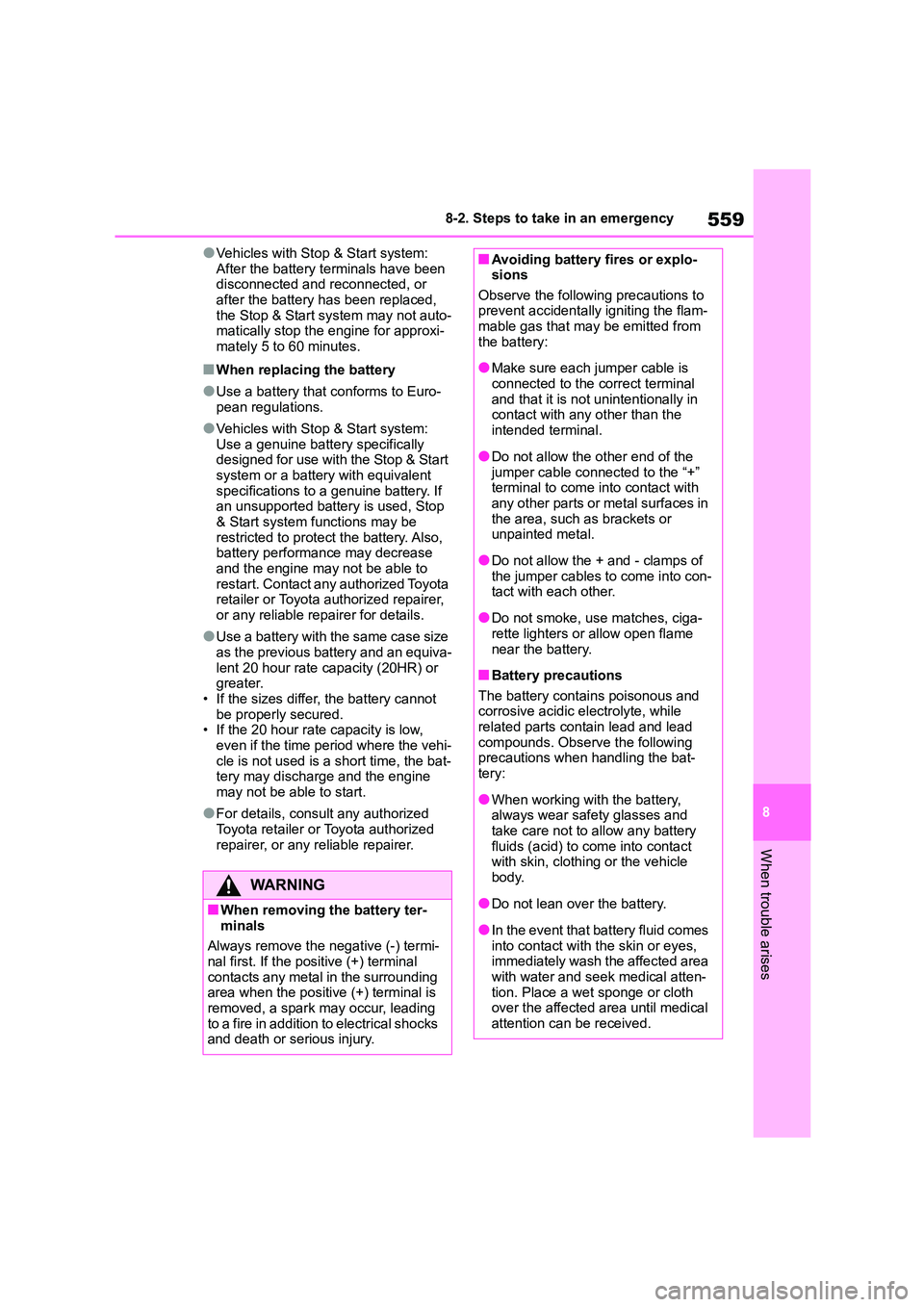
559
8
8-2. Steps to take in an emergency
When trouble arises
●Vehicles with Stop & Start system:
After the battery terminals have been disconnected and reconnected, or
after the battery has been replaced,
the Stop & Start system may not auto- matically stop the engine for approxi-
mately 5 to 60 minutes.
■When replacing the battery
●Use a battery that conforms to Euro-
pean regulations.
●Vehicles with Stop & Start system:
Use a genuine battery specifically
designed for use with the Stop & Start system or a battery with equivalent
specifications to a genuine battery. If
an unsupported battery is used, Stop & Start system functions may be
restricted to protect the battery. Also,
battery performance may decrease and the engine may not be able to
restart. Contact any authorized Toyota
retailer or Toyota authorized repairer, or any reliable repairer for details.
●Use a battery with the same case size as the previous battery and an equiva-
lent 20 hour rate capacity (20HR) or
greater. • If the sizes differ, the battery cannot
be properly secured.
• If the 20 hour rate capacity is low, even if the time period where the vehi-
cle is not used is a short time, the bat-
tery may discharge and the engine may not be able to start.
●For details, consult any authorized Toyota retailer or Toyota authorized
repairer, or any reliable repairer.
WA R N I N G
■When removing the battery ter-
minals
Always remove the negative (-) termi-
nal first. If the positive (+) terminal
contacts any metal in the surrounding area when the positive (+) terminal is
removed, a spark may occur, leading
to a fire in addition to electrical shocks and death or serious injury.
■Avoiding battery fires or explo-sions
Observe the following precautions to
prevent accidentally igniting the flam- mable gas that may be emitted from
the battery:
●Make sure each jumper cable is
connected to the correct terminal
and that it is not unintentionally in contact with any other than the
intended terminal.
●Do not allow the other end of the
jumper cable connected to the “+”
terminal to come into contact with any other parts or metal surfaces in
the area, such as brackets or
unpainted metal.
●Do not allow the + and - clamps of
the jumper cables to come into con- tact with each other.
●Do not smoke, use matches, ciga-rette lighters or allow open flame
near the battery.
■Battery precautions
The battery contains poisonous and
corrosive acidic electrolyte, while related parts contain lead and lead
compounds. Observe the following
precautions when handling the bat- tery:
●When working with the battery, always wear safety glasses and
take care not to allow any battery
fluids (acid) to come into contact with skin, clothing or the vehicle
body.
●Do not lean over the battery.
●In the event that battery fluid comes
into contact with the skin or eyes, immediately wash the affected area
with water and seek medical atten-
tion. Place a wet sponge or cloth over the affected area until medical
attention can be received.
Page 564 of 758
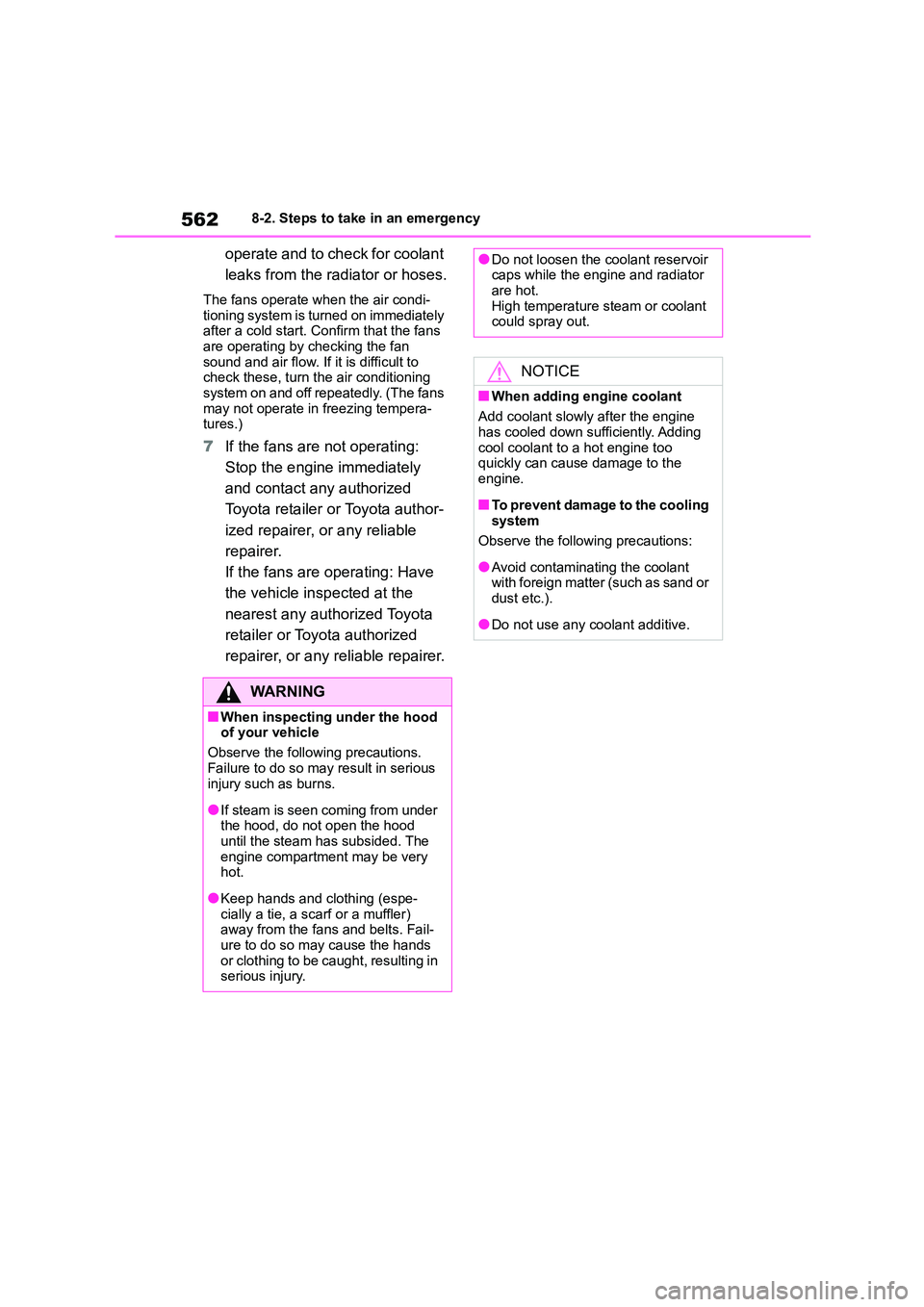
5628-2. Steps to take in an emergency
operate and to check for coolant
leaks from the radiator or hoses.
The fans operate when the air condi-
tioning system is tu rned on immediately after a cold start. Confirm that the fans
are operating by checking the fan
sound and air flow. If it is difficult to check these, turn the air conditioning
system on and off r epeatedly. (The fans
may not operate in freezing tempera- tures.)
7 If the fans are not operating:
Stop the engine immediately
and contact any authorized
Toyota retailer or Toyota author-
ized repairer, or any reliable
repairer.
If the fans are operating: Have
the vehicle inspected at the
nearest any authorized Toyota
retailer or Toyota authorized
repairer, or any reliable repairer.
WA R N I N G
■When inspecting under the hood
of your vehicle
Observe the following precautions.
Failure to do so may result in serious
injury such as burns.
●If steam is seen coming from under
the hood, do not open the hood until the steam has subsided. The
engine compartment may be very
hot.
●Keep hands and clothing (espe-
cially a tie, a scarf or a muffler) away from the fans and belts. Fail-
ure to do so may cause the hands
or clothing to be caught, resulting in serious injury.
●Do not loosen the coolant reservoir caps while the engine and radiator
are hot.
High temperature steam or coolant could spray out.
NOTICE
■When adding engine coolant
Add coolant slowly after the engine
has cooled down sufficiently. Adding cool coolant to a hot engine too
quickly can cause damage to the
engine.
■To prevent damage to the cooling
system
Observe the following precautions:
●Avoid contaminating the coolant with foreign matter (such as sand or
dust etc.).
●Do not use any coolant additive.
Page 565 of 758
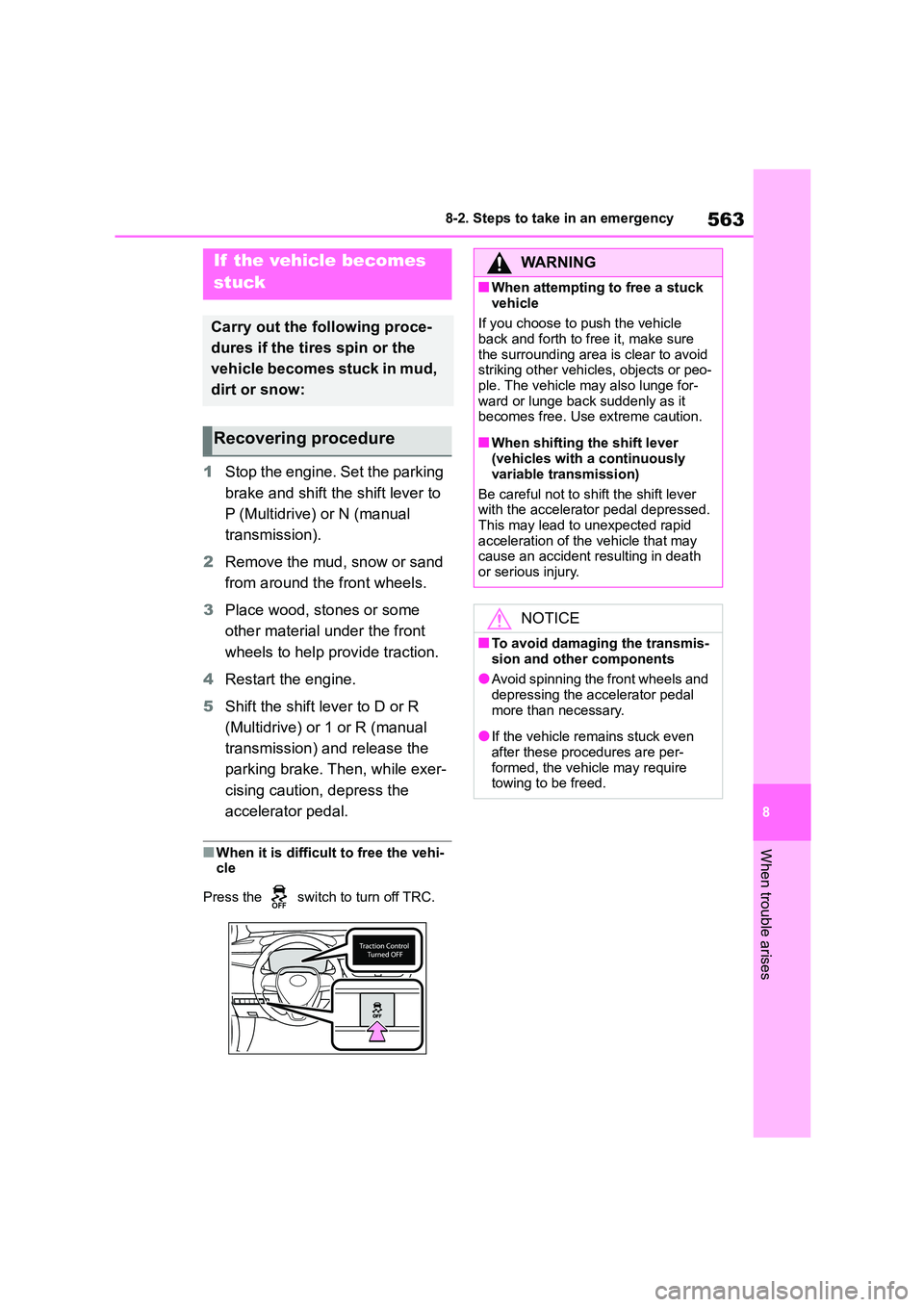
563
8
8-2. Steps to take in an emergency
When trouble arises
1 Stop the engine. Set the parking
brake and shift the shift lever to
P (Multidrive) or N (manual
transmission).
2 Remove the mud, snow or sand
from around the front wheels.
3 Place wood, stones or some
other material under the front
wheels to help provide traction.
4 Restart the engine.
5 Shift the shift lever to D or R
(Multidrive) or 1 or R (manual
transmission) and release the
parking brake. Then, while exer-
cising caution, depress the
accelerator pedal.
■When it is difficult to free the vehi- cle
Press the switch to turn off TRC.
If the vehicle becomes
stuck
Carry out the following proce-
dures if the tires spin or the
vehicle becomes stuck in mud,
dirt or snow:
Recovering procedure
WA R N I N G
■When attempting to free a stuck
vehicle
If you choose to push the vehicle back and forth to free it, make sure
the surrounding area is clear to avoid
striking other vehicles, objects or peo- ple. The vehicle may also lunge for-
ward or lunge back suddenly as it
becomes free. Use extreme caution.
■When shifting the shift lever
(vehicles with a continuously
variable transmission)
Be careful not to shift the shift lever
with the accelerator pedal depressed.
This may lead to unexpected rapid acceleration of the vehicle that may
cause an accident resulting in death
or serious injury.
NOTICE
■To avoid damaging the transmis-
sion and other components
●Avoid spinning the front wheels and depressing the accelerator pedal
more than necessary.
●If the vehicle remains stuck even
after these procedures are per-
formed, the vehicle may require towing to be freed.
Page 586 of 758
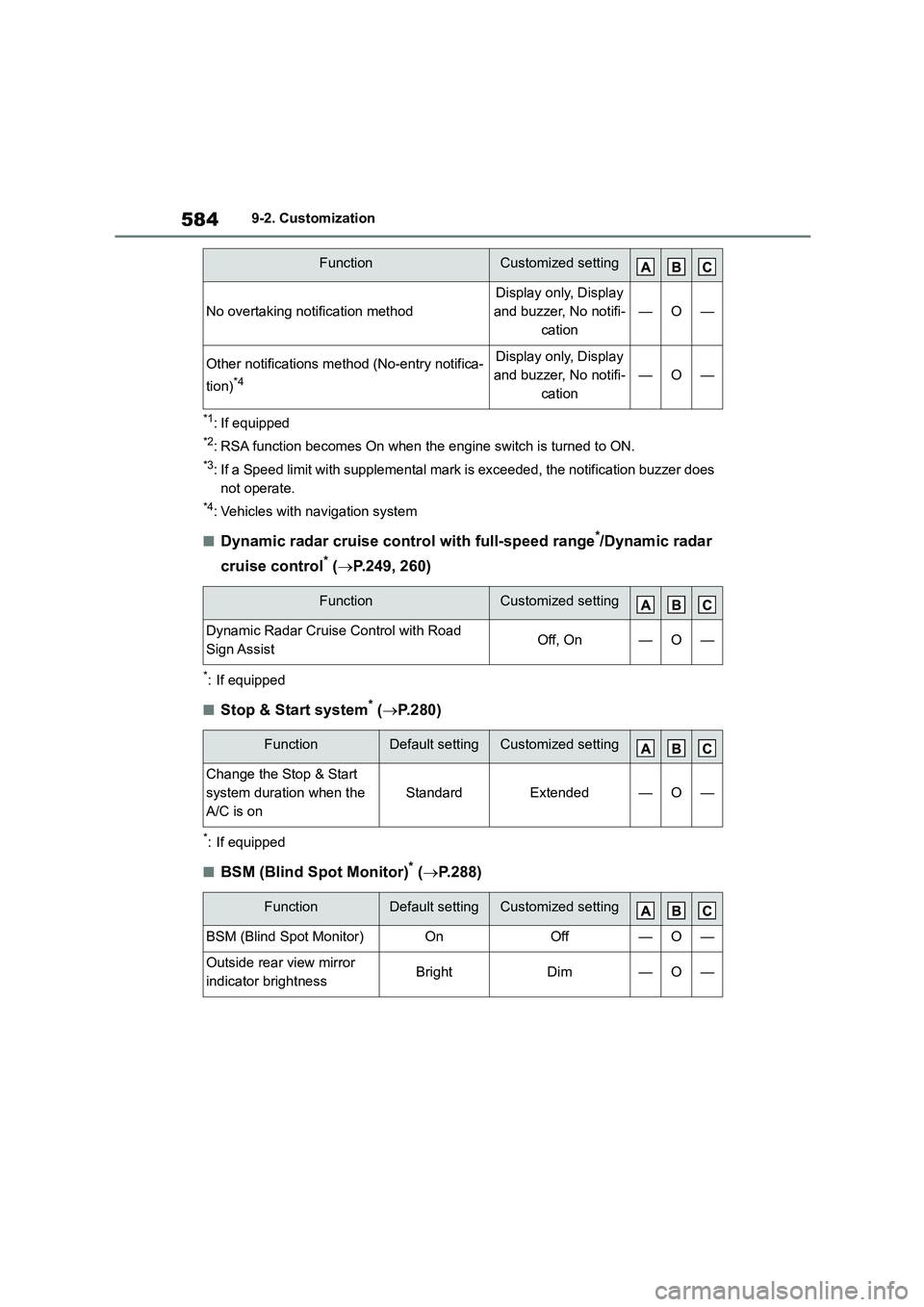
5849-2. Customization
*1: If equipped
*2: RSA function becomes On when the engine switch is turned to ON.
*3: If a Speed limit with supplemental mark is exceeded, the notification buzzer does
not operate.
*4: Vehicles with navigation system
■Dynamic radar cruise control with full-speed range*/Dynamic radar
cruise control* ( P.249, 260)
*: If equipped
■Stop & Start system* (P.280)
*: If equipped
■BSM (Blind Spot Monitor)* (P.288)
No overtaking notification method
Display only, Display
and buzzer, No notifi-
cation
—O—
Other notifications method (No-entry notifica-
tion)*4
Display only, Display
and buzzer, No notifi-
cation
—O—
FunctionCustomized setting
Dynamic Radar Cruise Control with Road
Sign AssistOff, On—O—
FunctionDefault settingCustomized setting
Change the Stop & Start
system duration when the
A/C is on
StandardExtended—O—
FunctionDefault settingCustomized setting
BSM (Blind Spot Monitor)OnOff—O—
Outside rear view mirror
indicator brightnessBrightDim—O—
FunctionCustomized setting
Page 593 of 758
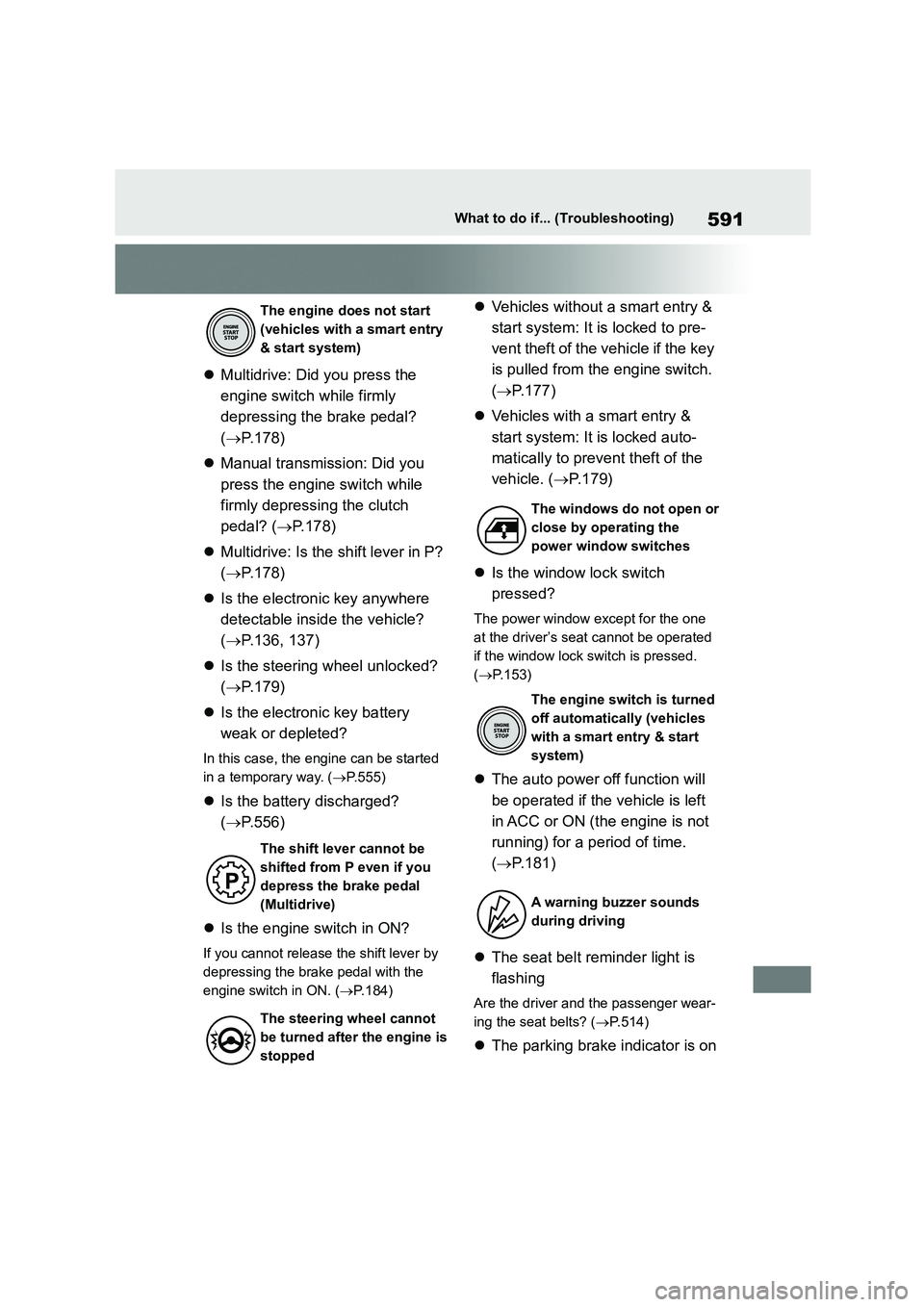
591What to do if... (Troubleshooting)
Multidrive: Did you press the
engine switch while firmly
depressing the brake pedal?
( P.178)
Manual transmission: Did you
press the engine switch while
firmly depressing the clutch
pedal? ( P.178)
Multidrive: Is the shift lever in P?
( P.178)
Is the electronic key anywhere
detectable inside the vehicle?
( P.136, 137)
Is the steering wheel unlocked?
( P.179)
Is the electronic key battery
weak or depleted?
In this case, the engine can be started
in a temporary way. ( P.555)
Is the battery discharged?
( P.556)
Is the engine switch in ON?
If you cannot release the shift lever by
depressing the brake pedal with the
engine switch in ON. ( P.184)
Vehicles without a smart entry &
start system: It is locked to pre-
vent theft of the vehicle if the key
is pulled from the engine switch.
( P.177)
Vehicles with a smart entry &
start system: It is locked auto-
matically to prevent theft of the
vehicle. ( P.179)
Is the window lock switch
pressed?
The power window except for the one
at the driver’s seat cannot be operated
if the window lock switch is pressed.
( P.153)
The auto power off function will
be operated if the vehicle is left
in ACC or ON (the engine is not
running) for a period of time.
( P.181)
The seat belt reminder light is
flashing
Are the driver and the passenger wear-
ing the seat belts? ( P.514)
The parking brake indicator is on
The engine does not start
(vehicles with a smart entry
& start system)
The shift lever cannot be
shifted from P even if you
depress the brake pedal
(Multidrive)
The steering wheel cannot
be turned after the engine is
stopped
The windows do not open or
close by operating the
power window switches
The engine switch is turned
off automatica lly (vehicles
with a smart entry & start
system)
A warning buzzer sounds
during driving
Page 594 of 758

592What to do if... (Troubleshooting)
Is the parking brake released?
( P.189)
Depending on the situation, other
types of warning buzzer may also
sound. ( P.511, 520)
Did anyone inside the vehicle
open a door during setting the
alarm?
The sensor detects it and the alarm
sounds. ( P.81)
Do one of the following to deacti-
vate or stop the alarms:
Unlock the doors using the entry
function (if equipped) or wireless
remote control.
Starting the engine. (The alarm
will be deactivat ed or stopped
after a few seconds.)
Is the electronic key left inside
the vehicle?
Check the message on the multi-infor-
mation display. ( P.520)
When a warning light turns on or
a warning message is displayed,
refer to P.511, 520.
Vehicles with an emergency tire
puncture repair kit: Stop the vehi-
cle in a safe place and repair the
flat tire temporarily with the
emergency tire puncture repair
kit. ( P. 5 2 2 )
Vehicles with spare tire: Stop the
vehicle in a safe place and
replace the flat tire with the spare
tire. ( P.539)
Try the procedure for when the
vehicle becomes stuck in mud,
dirt, or snow. ( P.563)
An alarm is activated and the
horn sounds (vehicles with
an alarm)
A warning buzzer sounds
when leaving the vehicle
(vehicles with a smart entry
& start system)
A warning light turns on or a
warning message is dis-
played
When a problem has
occurred
If you have a flat tire
The vehicle becomes stuck
Page 597 of 758
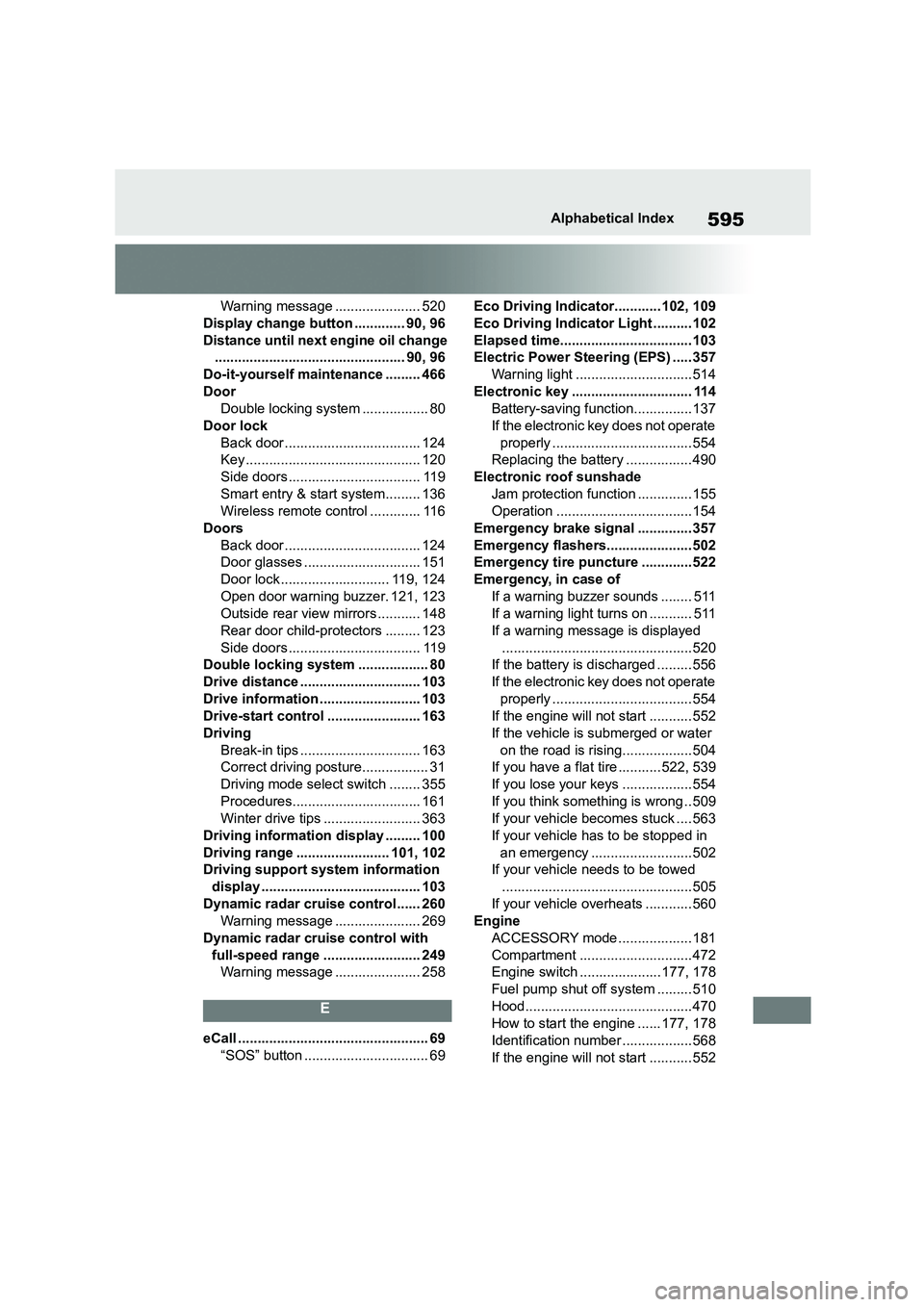
595Alphabetical Index
Warning message ...................... 520
Display change button ............. 90, 96
Distance until next engine oil change
................................................. 90, 96
Do-it-yourself maintenance ......... 466
Door
Double locking system ................. 80
Door lock
Back door ................................... 124
Key ............................................. 120
Side doors .................................. 119
Smart entry & start system......... 136
Wireless remote control ............. 116
Doors
Back door ................................... 124
Door glasses .............................. 151
Door lock ............................ 119, 124
Open door warning buzzer. 121, 123
Outside rear view mirrors ........... 148
Rear door child-protectors ......... 123
Side doors .................................. 119
Double locking system .................. 80
Drive distance ............................... 103
Drive information .......................... 103
Drive-start control ........................ 163
Driving
Break-in tips ............................... 163
Correct driving posture................. 31
Driving mode select switch ........ 355
Procedures................................. 161
Winter drive tips ......................... 363
Driving information display ......... 100
Driving range ........................ 101, 102
Driving support system information
display ......................................... 103
Dynamic radar cruise control ...... 260
Warning message ...................... 269
Dynamic radar cruise control with
full-speed range ......................... 249
Warning message ...................... 258
E
eCall ................................................. 69
“SOS” button ................................ 69
Eco Driving Indicator............ 102, 109
Eco Driving Indicator Light ..........102
Elapsed time.................................. 103
Electric Power Steer ing (EPS) ..... 357
Warning light ..............................514
Electronic key ............................... 114
Battery-saving function...............137
If the electronic key does not operate
properly .................................... 554
Replacing the battery ................. 490
Electronic roof sunshade
Jam protection function .............. 155
Operation ...................................154
Emergency brake signal .............. 357
Emergency flashers...................... 502
Emergency tire puncture .............522
Emergency, in case of
If a warning buzzer sounds ........ 511
If a warning light turns on ........... 511
If a warning message is displayed
.................................................520
If the battery is discharged ......... 556
If the electronic key does not operate
properly .................................... 554
If the engine will not start ........... 552
If the vehicle is submerged or water
on the road is rising..................504
If you have a flat tire ........... 522, 539
If you lose your keys ..................554
If you think something is wrong .. 509
If your vehicle becomes stuck .... 563
If your vehicle has to be stopped in
an emergency ..........................502
If your vehicle needs to be towed
.................................................505
If your vehicle overheats ............ 560
Engine
ACCESSORY mode .. ................. 181
Compartment .............................472
Engine switch .....................177, 178
Fuel pump shut off system .........510
Hood...........................................470
How to start the engine ...... 177, 178
Identification number ..................568
If the engine will not start ........... 552